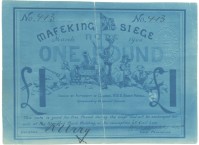|
Mafeking is a Baralong word meaning "Place of Stones" aptly
describing the environment. The Molopo river brought life to this otherwise
desolate place - separating the village of 6,000 Baralong Africans from the
small white town at Mafeking.
(Click on map above left for the exact location of Mafeking - making it
so vulnerable to Boer attack)
The small settlement of Mafeking was the vital rail link between the Cape
Colony to the south and Bechuanaland, a new territory being explored for
gold and minerals by Cecil Rhodes' British South Africa Company. It was at
Mafeking that the ill-fated Jameson raid which was launched against the Transvaal
Republic on new year's day in 1896 - that made this vulnerable and isolated
British-held settlement such a prize for the Boers under General Cronje -
the leader who had earlier routed the British at Majuba. The only way to
Mafeking was by rail through the Orange Free State - and with the outbreak
of war this link was immediately severed by the Boers to the south near Vryburg
- cutting off the small white English community of 1200 men, women and children.
When the siege began Rhodes' British South Africa Company in Bechuanaland
and at Bulawayo was isolated.... resulting in the
Marshall Hole currency at Bulawayo.
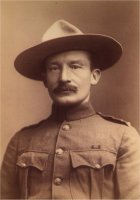 Colonel
Robert Stephenson Smith Baden-Powell (image right) was a Commander
of Rhodesian forces in the fall of 1899. As hostilities were imminent with
the Dutch Boers, Baden Powell, commanding a highly trained commando force,
determined to defend the small town of Mafeking which lay on the main railroad
line between Kimberley and Bulawayo. What was remarkable about Powell's defense
is that much of it consisted of deception. He had his soldiers bury fake
landmines, string invisible barb-wire and moved his few cannons around each
night giving the Boers the impression that the town was much better defended
than was actually the case. Colonel
Robert Stephenson Smith Baden-Powell (image right) was a Commander
of Rhodesian forces in the fall of 1899. As hostilities were imminent with
the Dutch Boers, Baden Powell, commanding a highly trained commando force,
determined to defend the small town of Mafeking which lay on the main railroad
line between Kimberley and Bulawayo. What was remarkable about Powell's defense
is that much of it consisted of deception. He had his soldiers bury fake
landmines, string invisible barb-wire and moved his few cannons around each
night giving the Boers the impression that the town was much better defended
than was actually the case.
Colonel Baden-Powell is best known as the man who founded the Boy Scout Movement
in 1908 but, in military terms, it was his earlier defence of the small town
of Mafeking for 217 days from October 1899 to May 1900 that reveals his ingenuity
in times of duress. The Boers laid siege to Mafeking on 12th October 1899
- the day after hostilities with the British broke out.
Even the inhabitants of Mafeking during the siege recognised the esteem of
the unique man in the unique times they faced - see the poem to the right
of his image.
It took a special man to save the day... and Baden-Powell was that man. The
Baralong had a word for Baden Powell, calling him "Impeesa" or the
wily wolf that never sleeps. Major Godley noted "His courage
was unbounded, his versatility was extraordinary, and his sympathy with all
sections of the community most marked."
(More
on Baden-Powell at this link). |
"B.P"
Printed in the Mafeking Mail Special Siege Slip on 6th April 1900 (see
below)
Our Colonel's a jolly good fellow
An out and out stunner is he
And this you may bet, that we'll never forget
Our gallant commander B-P
Do you mind how the boer that first morning
Thought to walk in our town with Cronje
But from Dixon's lookout they were soon put to rout
They found 'twas no joke with B-P
Then they brought their great 94 pounder
A blustering person is she
But soon o'er the town, there were holes to run down
And again they were sold by B-P
Snyman fired at our women and children
Nine shells in the Laager sent he
So Dutch spies straightaway, were sent there all day
That was wondrous cute of B-P
They think that we're eating each other
But that is because they can't see
The wonderful way we are fed on "ground hay"
Through the forethought and care of B-P
And when in the general rejoicing
When troops have arrived and we're free
I feel there'll be sighs and tears in our eyes
When bidding farewell to B-P |
Return to top of page
Under Baden-Powell's command the small besieged community at Mafeking established
a newspaper (siege slips), which were
printed on thin paper in an underground printing press.
These historic daily papers printed on any paper (see below) that could be
found were distributed in Mafeking throughout the length of the siege. Many
of the articles are quite cheeky, poking fun at their boer besiegers, but
the overriding theme was that the people of Mafeking must stand fast.
Baden-Powell's siege newspaper
Some of the Mafeking Mail siege slips in the Balson Holdings Family
Trust collection valued at about US$50 each
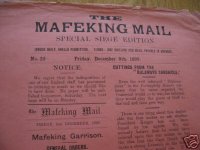 |
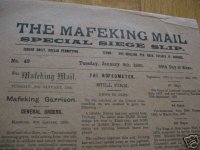 |
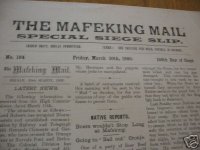 |
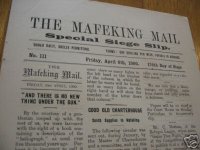 |
8th December 1899 -
red paper |
9th January 1900 -
very thin paper |
30th March 1900 -
thick paper |
6th April 1900 -
thick paper |
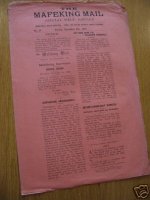 |
|
|
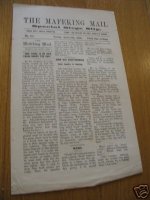 |
Return to top of page
As normal commerce was interrupted and rationing ordered, Powell issued 1,
2 and 3 shilling coupons as well as as ten-shilling and one-pound notes.
From February to March 1900, these notes were printed in an underground shelter
on ordinary writing paper. As the notes were released into circulation, the
Army Paymaster, Capt. Greener, collateralized the notes by depositing checks
of an equivalent amount into the Mafeking branch of the Standard Bank of
South Africa, which were accepted by Robert Bradshaw Urry, the manager.
Robert Bradshaw Clarke Urry, the then manager of the Standard Bank at Mafeking
in South Africa, co-signed the ten-shilling and one-pound siege notes with
the "Army Pay master", Captain Greener.
(All the notes shown here are in the Balson Holdings Family Trust
Collection)
The ten-shilling note was printed from a woodcut, using a croquet mallet
cut in half for the block. As each issue of notes was released into circulation,
the army paymaster gave the notes authority by depositing a cheque of an
equivalent amount into the Mafeking branch of the Standard Bank of South
Africa. The issue
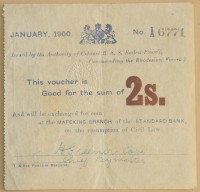 could
thus be redeemed at that bank following the resumption of civil law. So few
of the notes and coupons were actually redeemed that it created a rather
fat bank account and later raised questions of faulty accounting. The last
notes were redeemed in 1908.
could
thus be redeemed at that bank following the resumption of civil law. So few
of the notes and coupons were actually redeemed that it created a rather
fat bank account and later raised questions of faulty accounting. The last
notes were redeemed in 1908.
Over £5,228 in notes and coupons were issued, however, little more than
£638 were ever redeemed. The rest were kept as souvenirs of the seige
of Mafeking or lost, and redemption of the notes ceased in September 1908.
As Baden-Powell later noted,
The design for the one-pound note I drew on a boxwood
block, made from a croquet mallet cut in half, and this I handed to a Mr.
Riesle, who had done wood engraving. But the result was not satisfactory
from the artistic point of view, so we used that as a ten-shilling note and
I drew another design which was photographed for the pound note (image right
below).
These could all be exchanged for cash if presented
within six months of the end of the siege. But none of them were presented,
since people kept them or sold them as interesting mementos.
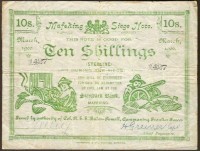
Thus the Government scored at least six thousand
pounds and for two years afterwards were calling on me for explanation of
what they supposed was faulty bookkeeping which showed us so much to the
credit. Sentiment didn't enter into their calculations.
The Balson Holdings Family Trust holds the very rare 1/-, 2/- £1 (extremely rare - see below) and
two copies of the 10/- note with the incorrect and correct spelling of the word
"Commanding" (see below). This spelling error was corrected
soon after its discovery and most 10/- siege notes are spelt correctly.

Value in 2010: The Mafeking siege £1 bank notes are highly sought after - valued at over US$2,000
in Unc. Rarely seen on auction.
A
taped and badly damaged 10s Mafeking siege note
sold for over US$120 on eBay in August 2005.
Return to top of page
Mafeking One Pound Seige Note (VF/EF) in the Balson Holdings Family Trust Collection. The note has a fold down the middle but is intact and both signatures are clear. Extremely rare in this condition.
Purchased from Randburg Coins in Johannesburg for US$1,500 on BidorBuy in January 2010
Edward Ross, Mafeking's auctioneer, is best-known for his role in the production
of banknotes during the siege. His diary is amongst the finest of the many
accounts of the siege, recording the activities of Mafeking's residents as
well as the military aspects of the siege.
Ross notes: I had a little signboard printed,
“Mafeking Mint. No Admission”, but this was regarded
by everybody as a joke, most people saying, “Well, if there’s no
admission, I’m going in to see what’s going on,” and sometimes
when the bell rang the “Mint” was packed. Not much use trying to
keep it private. Of course everything did not work smoothly; for instance,
one morning Greener sent me a batch of paper, and only in the light could
it be seen that he had got hold of some old B.B.P.
(Bechuanaland Border Police) notepaper with
their crest at the top. Naturally this could not be used, and so a fresh
batch had to be made the next evening.
This note business is going to be a good thing for the Government as I am
sure they will be worth much more than face value as curios after the siege,
and people are collecting as many as they can get hold of now, to make money
afterwards, and as I have made 620 that means
about £600 clear profit for the Imperial exchequer! And that’s
how the £1 note was made....
And the 1/- and 2/- notes used in the canteens as Ross
notes: You’ll no doubt remember we’ve had a Good Friday during
the siege well, our baker, who I suppose has a bit of humour in him, reminded
us of the fact by putting a cross in the shape of two rough furrows in our
daily ration of hard-baked horse oat bread. This stuff we have got to eat
or go without anything at all, and is made out of badly crushed oats, with
half the husks left in just to give you something to do in the way of picking
your teeth, taking the sharp pointed pieces out of your gums with a pair
of tweezers, etc. It is made into a sort of round dog-biscuit about inches
in diameter and half an inch in thickness. If you break a piece off the husks
stick out in such a manner that it makes a splendid substitute for a toothbrush.
But it is not good from a really serious point of view as believe it has
already sent one or two to the hospital with “perforatin [sic] of the
bowels”. Talking of eating, the horsemeat is really not so bad, jus
a little sweet that’s all. What we do is to put our biscuit and our
meat ration into a pot with some water and let it cook for three or four
hours. This soup we have for one meal in the morning and the balance for
dinner late in the afternoon, that fixes us up until the next morning. Sometimes
we get a snack of lunch in the shape of “Brawn” made from the
following: horse hoofs, horse heads, cow hide, donkey meat, carpenters’
glue, spice and split peas. One cannot get through very much of this, but
the natives seem to highly appreciate it and get full up with it. I think
everything in the place has been eaten except horseshoes and barbed wire.
I of course must not forget our “Sowen porridge”: this is a skilfully
made from fermented oats; this is not very palatable, but it fills the vacuum
for a couple of hours. When this was first made everybody, white and black,
turned up their noses at it, but now it is, “Please give me a quart
of sowens,” for which you gladly pay your sixpence.
On the eating tack reminds me that some artful johnny has managed to keep
a fowl down in his dugout all this time, and he has now sold it by auction
and has put into his pocket the nice little sum of 30/-.
Return to top of page
Who is Baden-Powell
Robert Stephenson Smyth Baden-Powell, 1st Baron Baden-Powell (22 February
1857 – 8 January 1941), also known as B-P, was a lieutenant-general
in the British Army, writer, and founder of the Scout Movement. After having
been educated at Charterhouse School, Baden-Powell served in the British
Army from 1876 until 1910 in India and Africa. In 1899, during the Second
Boer War in South Africa, Baden-Powell successfully defended the city in
the Siege of Mafeking.
Images below: Scan of letter written by Baden Powell
and reverse in the Balson Holdings Family Trust
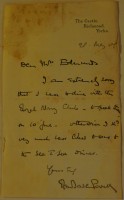
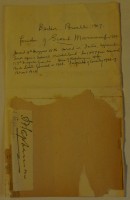
Several of his military books, written for military reconnaissance and scout
training in his African years, were also read by boys. Based on those earlier
books, he wrote Scouting for Boys, published in 1908 by Pearson, for youth
readership. During writing, he tested his ideas through a camping trip on
Brownsea Island that began on 1 August 1907, which is now seen as the beginning
of Scouting. After his marriage with Olave St Clair Soames, Baden-Powell,
his sister Agnes Baden-Powell and notably his wife actively gave guidance
to the Scouting Movement and the Girl Guides Movement. Baden-Powell lived
his last years in Nyeri, Kenya, where he died in 1941.
Return to top of page
The siege of Mafeking impacted on Bechuanaland (now Botswana) and on the new settlement at Bulawayo in Rhodesia (now Zimbabwe) to the north where the Civil Commissioner of the British South
Africa Company, Marshall Hole, also used a creative method to overcome the
shortage of circulating money - issuing cards with
postage stamps on them.
Return to top of page
.
Pres Burgers
[1872: Zuid Afrikaansche Republiek (ZAR)
£1 Note] [1874: Coarse Beard Burgers Pond] [1874: ZAR Patterns]
Pres Paul Kruger
[1892 Double Shafted Coins] [1892
- 1900: ZAR Paul Kruger Coins] [OFS Postal
Notes]
[1900 Pretoria Bank Notes] [1901
Pietersburg Bank Notes] [1902 Te Velde Bank
Notes] [Boer POW notes]
[1902: Veld Pond] [ZAR
Coins tampered with by Boer and British Prisoners of War (POWs)]
[Boer POW bank notes]
Boer War Siege notes and exonumia
[1893 Bechuanaland Border Police
Coins] [1899- 1900: Mafeking Siege Notes and Newspaper
Siege Slips]
[1900 Marshall Hole Bulawayo Card Currency]
Miscellaneous Exonumia
[Who is Paul Kruger]
[Title Deeds signed by Kruger]
[Lord Roberts' proclamation of Kruger's desertion
- Sept 1900]
[Contemporary Books on Boer War]
[Kruger's Unique Family Photo]
[Other Boer Coins & Medallions]
[Zuid Afrikaansche Republiek Coins and Notes]
[Web Site Text Site Map]
[Tokencoins.com Home Page]


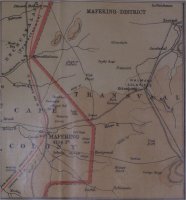 Introduction
Introduction
 Colonel
Robert Stephenson Smith Baden-Powell (image right) was a Commander
of Rhodesian forces in the fall of 1899. As hostilities were imminent with
the Dutch Boers, Baden Powell, commanding a highly trained commando force,
determined to defend the small town of Mafeking which lay on the main railroad
line between Kimberley and Bulawayo. What was remarkable about Powell's defense
is that much of it consisted of deception. He had his soldiers bury fake
landmines, string invisible barb-wire and moved his few cannons around each
night giving the Boers the impression that the town was much better defended
than was actually the case.
Colonel
Robert Stephenson Smith Baden-Powell (image right) was a Commander
of Rhodesian forces in the fall of 1899. As hostilities were imminent with
the Dutch Boers, Baden Powell, commanding a highly trained commando force,
determined to defend the small town of Mafeking which lay on the main railroad
line between Kimberley and Bulawayo. What was remarkable about Powell's defense
is that much of it consisted of deception. He had his soldiers bury fake
landmines, string invisible barb-wire and moved his few cannons around each
night giving the Boers the impression that the town was much better defended
than was actually the case.
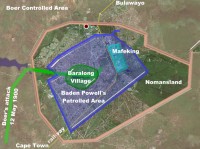






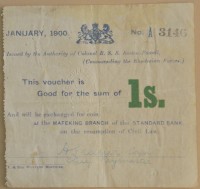 Baden-Powell's siege banknotes
Baden-Powell's siege banknotes


